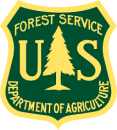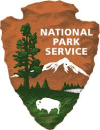Location



















States
ArizonaEcosystem
ForestIntroduction
Grand Canyon National Park (GRCA) spans over 1.2 million acres on the Colorado Plateau in northwestern Arizona. The Grand Canyon, incised by the Colorado River, is a UNESCO World Heritage Site that draws over five million visitors annually. The park is surrounded by semi-arid desert, but there are a number of distinct habitat types along the 8,000-foot elevation gradient of the canyon itself. Riparian habitat occurs at the bottom of the canyon along the Colorado River and transitions into ponderosa pine forest as elevation increases. Montane meadows and subalpine grassland communities are rare and only occur on the North Rim, at 8,200 feet.
Introduction of invasive species invasive species
An invasive species is any plant or animal that has spread or been introduced into a new area where they are, or could, cause harm to the environment, economy, or human, animal, or plant health. Their unwelcome presence can destroy ecosystems and cost millions of dollars.
Learn more about invasive species and fire suppression policies have led to fuel load build-up at GRCA. Increased fuel loads combined with climate change climate change
Climate change includes both global warming driven by human-induced emissions of greenhouse gases and the resulting large-scale shifts in weather patterns. Though there have been previous periods of climatic change, since the mid-20th century humans have had an unprecedented impact on Earth's climate system and caused change on a global scale.
Learn more about climate change impacts, such as rising temperatures and shifts in vegetation patterns, have increased the risk of severe wildfire that can degrade the landscape (White et al., 2023). Since 1980, the National Park Service (NPS) has used prescribed fire as a relatively affordable and effective tool to increase landscape-scale climate Resilience, as described in Sample et al. (2022), in GRCA. Under the right conditions, fire can thin forests and reduce fuel loads, thereby reducing the risk and severity of future fires. Fire also recycles nutrients into soil and stimulates new plant growth, benefitting many wildlife species.
The Roost project block is located on the North Rim of GRCA. It spans 30,350 acres of mixed conifer, aspen, spruce/fir, and ponderosa pine stands, including swathes of critical recovery habitat for the endangered Mexican spotted owl (Strix occidentalis lucida). Over the past century, fire was aggressively suppressed in the Roost project block for fear of wildfires spreading uncontrollably. Now, NPS and the U.S. Forest Service (USFS) are implementing a robust prescribed burning program in this block, looking for the safest and most efficient ways to apply fire. Prescribed burning protects native biodiversity and enhances landscape Resilience to climate change impacts by maintaining healthy forest and grassland ecosystems and preventing large, uncontrolled fires.
Key Issues Addressed
The Roost project block is a continuous landscape devoid of many boundary features that would usually buffer fire such as roads, large changes in topography or elevation, canyons, or drainages which could prevent a wildfire from spreading. This area therefore lacks Resilience, and if it was subject to a large fire under unfavorable weather conditions, it could result in the loss of this entire habitat, destroying its structural integrity.
As the climate becomes more variable, weather factors are increasingly difficult to track and predict. This decreases the overlap between ideal burning conditions and lower levels of tourism. Numerous factors must align for conditions to be right for a burn on the North Rim slopes. The safest time to implement prescribed fire is in the fall, the shoulder season of tourism when GRCA receives fewer visitors. A number of seasonal trends indicate ideal burning conditions: shorter days with less solar radiation, cooler nights, higher relative humidities approaching dew points, and increased chance of precipitation. These factors increase the likelihood of a fire slowing down within a few days of ignition.
In the Roost project block, previous site inaccessibility due to lack of drivable internal roads prevented managers from implementing prescribed fire, compounding already significant fuel buildup. Forest landscapes such as the Roost project block were previously adapted to frequent fires. However, over the last century, fire suppression has been the dominant fire management strategy in the western United States, which resulted in fuel buildup. This buildup increases potential for large, high-intensity wildfires that endanger human safety and could result in irreversible changes to vegetation composition.
Project Goals
- Utilize topography to identify areas where fire can be introduced safely. Due to the lack of traditional boundary features in the Roost project block, the NPS and USFS interagency fire management team must identify areas of the landscape with the lowest risk of catastrophic wildfire to access and introduce fire safely.
- Review detailed and localized weather data to plan and manage prescribed fire. The interagency management team tracks environmental and weather variables such as wind speed, wind direction, relative humidity, and precipitation conditions to calculate precise measures of anticipated fire intensity. The team then implements fire at ideal times when they are most likely to meet fuel reduction objectives and control the burn.
- Overcome limited road access by exploring innovative ways to reintroduce fire to reduce dead and downed woody fuels by at least 25% in the Roost project block. Reducing fuel loads through prescribed burning decreases potential for severe and uncharacteristic fires and decreases risks to human safety, biodiversity, landscape integrity, and property.
Project Highlights
- Backburning Down Canyon Slopes Protects Landscape Integrity and Resilience: Managers have successfully implemented prescribed fire in an area that is difficult to access, covering 30-40% of the Roost project block after three burns. Due to the lack of natural boundary features, managers light burns along ridgetops and slopes with southerly aspects, so fires burn downslope against the prevailing wind, which contains the burn. This reduces the risk of fire escaping the target area. They light 5-10 small ridgeline (i.e. 100-500 acres), low severity fires during the tourism shoulder season instead of waiting multiple years to implement one large burn which would be harder to control. While the Roost project block has experienced several small lightning-caused wildfires in recent years, they were all suppressed quickly, and there have been no problematic fires in the Roost project block between 2019 and 2024.
- Incident Meteorologists Improve Weather Forecasting Confidence: In 2023, fire managers began working with dedicated incident meteorologists (IMETs) who provide high quality, localized weather forecasting, analysis, and decision support. IMETs use detailed weather data including temperature, humidity, and wind speed to assess and predict potential fire behavior. It is increasingly important to track weather data as weather patterns become less predictable. Localized, detailed data help prevent unintended consequences of prescribed burns in a hotter, drier, and less predictable climate. IMETs provide near-real-time weather updates and up to date forecasting to management teams that are critical for keeping precise burns safely within the prescribed area, helping fire managers determine burn windows to meet treatment objectives, and preventing fires from burning for too long.
- Aerial Ignition Reduces Risk and Improves Access: Managers fly rotor-wing helicopters with plastic sphere dispensers over the Roost project block and drop plastic ping-pong balls filled with powdered chemical igniter at specified intervals. The balls burn and spread into the fuels in which they have landed. This novel aerial method limits exposure of staff to fire and smoke. It works particularly well for this large project area, allowing teams to access ridgetops quickly when dealing with a short ignition window to produce optimal results. Aerial ignition can cover 750-2,000 acres in a matter of hours, which would take multiple days for staff to reach on foot due to the difficult terrain and limited road access.
Lessons Learned
Fire managers have learned it is important to clearly communicate with the public about the use of prescribed fire in a popular national park like GRCA. The NPS and the Arizona Department of Environmental Quality (ADEQ)collaborate on public outreach and communication efforts to educate visitors, local residents, and other park stakeholders about air quality, health and visibility advisories, and potential impacts of smoke from prescribed burns. Implementing safety measures such as road closures and signage maximizes staff and visitor health and safety during these restoration efforts. Additionally, public perception and attitudes towards fire management in national parks, including GRCA, can influence visitor experiences and support for management initiatives. By engaging in transparent communication, public outreach, and collaborative decision-making, NPS and ADEQ seek to build trust, alleviate concerns, and foster public understanding of the benefits of prescribed fire for ecosystem health and climate Resilience.
The Roost project block demonstrates how placement and maintenance of infrastructure affects fire fighting ability. Before aerial ignition, lack of accessible roads was one major issue preventing proper fire management in this area, which led to dangerous levels of fuel buildup. Managers harnessed novel technology to overcome this barrier and safely reintroduce fire, but the Roost project block presents an opportunity to consider how fire and infrastructure might interact in the future. For example, future outdoor recreation areas can be designed more strategically by considering accessibility for prescribed fire management strategies.
Next Steps
- Expand the scale and impact of these fire techniques to other areas without boundary features: Based on successes from the Roost project block, managers are exploring opportunities to implement similar precise, data-driven burns. They aim to track weather conditions, take advantage of topography, and utilize aerial ignition in another continuous landscape block that is currently at high risk of experiencing high-intensity wildfire.
- Search for new tools to provide higher confidence weather data: As climate change effects continue to escalate, more detailed analytics are critical to track weather conditions and fire risk factors and determine ideal times to light prescribed burns.
- Explore use of unmanned aerial surveillance (UAS) drone technology to implement targeted fire: Developers hope that these drones will be able to harness artificial intelligence algorithms which can detect, map, and predict fire in real-time. However, this will require purchasing expensive pieces of technology and training a number of staff. Battery life and UAS capacity to carry a high number of ignition devices are currently additional limiting factors, so UAS implementation is unlikely to occur before 2029.
Funding Partners
National Park Service Intermountain Region Fire Management Program
Resources
- Aerial Ignitions with a Plastic Sphere Dispenser Operator
- Arizona Department of Environmental Quality (ADEQ)
- Sample et al. (2022). Adaptation Strategies and Approaches for Managing Fire in a Changing Climate. Climate, 10(4), 58.
- White et al. (2023). Ch. 28. Southwest. In: Fifth National Climate Assessment. U.S. Global Change Research Program, Washington, DC, USA.
Contact
Jimmy Flanagan, Fire Management Specialist, National Park Service/U.S. Forest Service: jimmy_flanagan@nps.gov
CART Lead Author
Erin Connolly, Drought Learning Network (DLN) Case Study Author
The DLN is a peer-to-peer knowledge exchange between climate service providers and resource managers, created to gather and share lessons learned from drought events to prepare for future events. The DLN partners with CART to develop Case Studies, with funding from the National Drought Mitigation Center for interns and coordination support from the USDA Southwest Climate Hub.
Suggested Citation
Connolly, E., E. (2025). “Prescription Slope Burns at Grand Canyon National Park Build Landscape Resilience.” CART. Retrieved from https://www.fws.gov/project/prescription-burns-grand-canyon-national-park.










